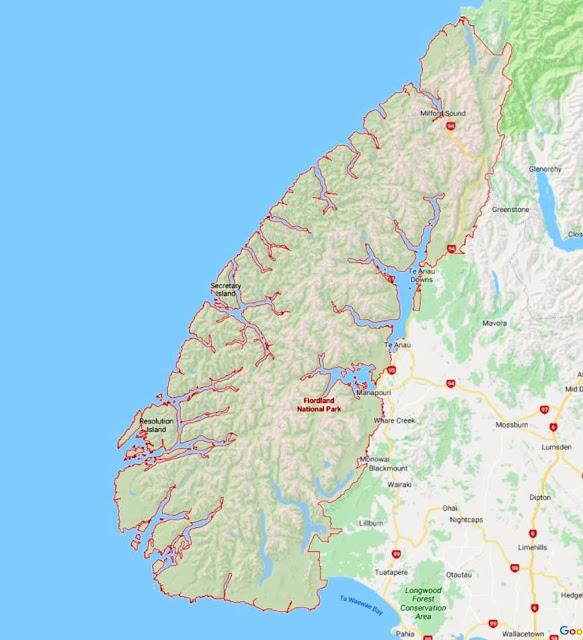Fiordland is in the south-western corner of New Zealand's
South Island. Most of Fiordland is
dominated by the steep sides of the snow-capped Southern Alps, deep lakes, and
its steep, glacier-carved and now ocean-flooded western valleys. The Fiordland National Park is New Zealand's
largest National Park.
Twelve fiords, some stretching up to 40 kilometres (25 miles)
inland, and two inlets leading to three more fiords, extend along the coast
from Milford Sound in the north to Preservation Inlet in the south. In general, the fjords become wider from north
to south as the height of the mountains decreases.
 |
| Fiordland is in the south-west corner of New Zealand |
Due to the often steep terrain and high amount of rainfall
supporting dense vegetation, the interior of the Fiordland region is largely
inaccessible. The fiords are typically
named 'sounds' even though
geologically they are not. Of the twelve
major fiords on Fiordland's west coast, Milford Sound is the most famous and the
only one accessible by road. Doubtful
Sound is much larger and is also a tourist destination, but is less accessible.
Also situated within Fiordland are Browne Falls and
Sutherland Falls, which rank among the tallest waterfalls in the world, and New
Zealand's three deepest lakes, Lake Hauroko, Lake Manapouri, and Lake Te Anau.
This part of New Zealand, especially to the west of the mountain
divide of the Southern Alps, has a very wet climate with annual average of 200
rainy days and annual rainfall varying from 1,200 millimetres (47 inches
or nearly 4 feet) in Te Anau to 8,000 millimetres (310 inches or over
25 feet) in Milford Sound. The
prevailing westerly winds blow moist air from the Tasman Sea onto the
mountains, resulting in high amounts of precipitation as the air rises and
cools down.
The tallest mountain in the Fiordland region is Mount Tutoko at 2,723 metres (8,934 ft), one of several peaks over 2,000 metres in the Darren Mountains. South-east of this area, there are only a handful of peaks reaching 2,000 metres, however due to the rainy weather with cold winters and lack of hot summer temperatures, even these mountains contain glaciers and peaks with permanent snow cover.
The tallest mountain in the Fiordland region is Mount Tutoko at 2,723 metres (8,934 ft), one of several peaks over 2,000 metres in the Darren Mountains. South-east of this area, there are only a handful of peaks reaching 2,000 metres, however due to the rainy weather with cold winters and lack of hot summer temperatures, even these mountains contain glaciers and peaks with permanent snow cover.

No comments:
Post a Comment